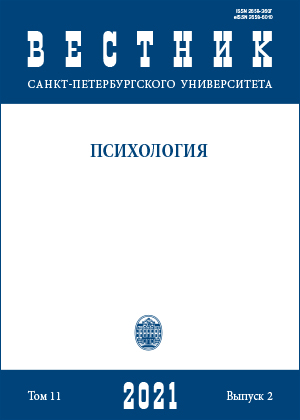Эмоциональный интеллект, черты Большой пятерки и эмоциональная креативность в латентных личностных профилях
DOI:
https://doi.org/10.21638/spbu16.2021.201Аннотация
Исследования последнего десятилетия при описании соотношения черт, образующих личностный профиль, либо демонстрировали взаимосвязи эмоционального интеллекта и Большой пятерки, либо произвольно выявляли в системе измеряемых свойств медиаторы и модераторы. Среди имеющихся на данный момент исследований отсутствуют достоверные сведения о латентных классах в контексте соотнесения свойств Большой пятерки с эмоциональной креативностью, которая, в свою очередь, связана с эмоциональным интеллектом. В связи с этим нашей целью является заполнение существующего пробела в знаниях и, соответственно, анализ латентных профилей для более полного раскрытия представленности в выделенных профилях этих компонентов. Выборку составили 527 испытуемых-студентов (из них 395 женщин и 135 мужчин, Min 17, Max 43, M = 19,2, SD = 2,9), 402 из них прошли всю батарею тестов. В комплекс методик вошли: 1) Ten Item Personality Measure — «Краткий опросник Большой пятерки» (КОБП); 2) Trait Emotional Intelligent Questionnaire — опросник «Черты эмоционального интеллекта», 3) Emotional Creativity Inventory — «Опросник эмоциональной креативности» Дж. Эверилла. Сопоставлялись результаты корреляционного анализа и анализа латентных профилей, в которых представлены типичные для четырех выделенных классов соотношения измеренных личностных свойств. В результате предпринятого исследования показано, что черты Большой пятерки ожидаемо положительно связаны со всеми чертами эмоционального интеллекта. Анализ латентных профилей позволил выделить четыре класса, которые не проявляются при использовании корреляционного анализа. Но именно свойства эмоционального интеллекта выступили основной группой дискриминирующих переменных при установлении личностных профилей. Выводы: из черт Большой пятерки только эмоциональная стабильность, а из эмоциональной креативности — только эффективность выступили дискриминирующими факторами; максимальный вклад в определение личностных профилей внесли черты эмоционального интеллекта.
Ключевые слова:
латентные профили, эмоциональная креативность, эмоциональный интеллект, опросник «Черты эмоционального интеллекта», «Краткий опросник Большой пятерки» (КОБП), «Опросник эмоциональной креативности»
Скачивания
Библиографические ссылки
S. Mavroveli // Keefer K. V., Parker J. D. A., Saklofske D. X. (eds). Emotional Intelligence in Education. Cham, Switzerland: Springer, 2018. P. 49–81 (The Springer Series on Human Exceptionality). https://doi.org/10.1007/978-3-319-90633-1_3
References
Wright, R., Riedel, R., Sechrest, L., Lane, R.D., Smith, R. (2018). Sex differences in emotion recognition ability: The mediating role of trait emotional awareness. Motivation and emotion, 42 (1), pp. 149–160. https://doi.org/10.1007/s11031-017-9648-0
Загрузки
Опубликован
Как цитировать
Выпуск
Раздел
Лицензия
Статьи журнала «Вестник Санкт-Петербургского университета. Психология» находятся в открытом доступе и распространяются в соответствии с условиями Лицензионного Договора с Санкт-Петербургским государственным университетом, который бесплатно предоставляет авторам неограниченное распространение и самостоятельное архивирование.




